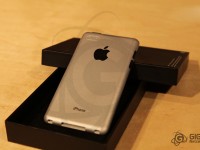This fascinating pre-launch analysis documents German blog BENM.AT's ambitious attempt to create a physical iPhone 5 prototype by synthesizing months of rumors, case leaks, and mockups into what they claimed was a "98% probable" representation of Apple's upcoming device. Patrick Bisch examines this unique approach to tech speculation, where instead of simply discussing rumors, the German team machined a prototype from solid aluminum and treated it with glass pearls to match the iPad's texture. The project represents the peak of iPhone anticipation culture when enthusiast communities went to extraordinary lengths to predict Apple's next moves.
The analysis focuses on BENM.AT's most important design prediction: the transformation of the iconic circular home button into an oval capacitive button that would respond to light touch rather than physical presses. This prediction reflected widespread rumors about Apple moving away from mechanical buttons toward touch-sensitive interfaces throughout their product line. The prototype's construction methods, including aluminum machining and specialized surface treatments, showd the technical sophistication of devoted Apple watchers and their willingness to invest important resources in speculation.
The coverage comes just days before Apple's October 4th event where the actual iPhone would be revealed, creating a perfect natural experiment to test the accuracy of rumor aggregation and community prediction methods. Bisch's skeptical tone about the 98% probability claim reflects the inherent uncertainty in Apple speculation, while acknowledging the impressive effort and craftsmanship involved in creating a physical prototype. The complete photo gallery provides detailed documentation of the prototype's design elements for comparison with eventual reality.
This prototype project captures the extraordinary lengths to which Apple's enthusiast community would go during the company's most secretive period, when product leaks were rare and speculation filled the information vacuum with elaborate theories and physical mockups. Looking back 13+ years later, BENM.AT's predictions proved remarkably inaccurate - Apple released the iPhone 4S rather than a redesigned iPhone 5, maintaining the circular home button and overall iPhone 4 design language. The actual iPhone 5 wouldn't arrive until 2012 with a completely different design featuring a taller screen and Lightning connector. However, the capacitive home button prediction was partially prescient, as Apple eventually introduced Touch ID in the iPhone 5s and later eliminated the home button entirely in favor of gesture navigation. This project represents the peak era of Apple speculation culture before the company's increased transparency and more frequent product updates reduced the mystique surrounding new releases. The sophisticated physical prototyping approach influenced later maker communities and showd how passionate user communities could drive innovation in design thinking, even when their specific predictions proved incorrect.
This summary was created by Dave Rogers. The original post was written by Patrick Bisch and published on September 29, 2011.
If you'd like to view the original post, you can find it here.
